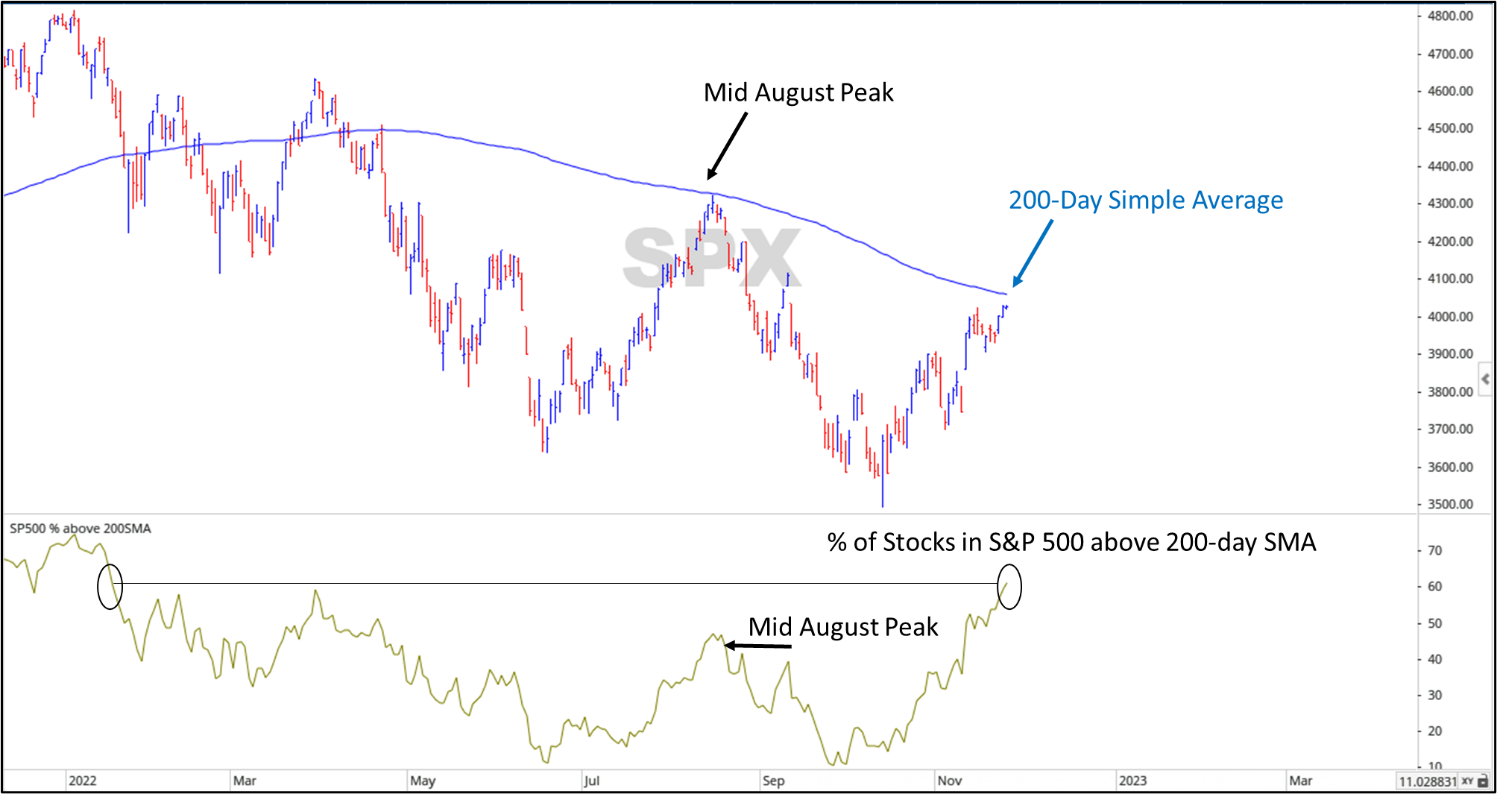We hope that everyone had a wonderful Thanksgiving Holiday!
It was a short, low volume week for the markets. Ten trading days have passed since the S&P 500’s wild +5% outlier day. Surprisingly, the markets have traded sideways through last Friday. It would have been typical to see more outliers following the biggest up day since March of 2020. As a result, volatility has been declining, bringing back some feelings of normality among investors. This could be considered to be a consolidation, or a digestion, of the advance. On the other hand, is this the quiet before a storm? Bear markets will do whatever it takes to confuse the masses. Time will tell which is the case.
Content continues below advertisement
Markets from a Technical (supply and demand) Perspective
From a market technician’s perspective, the S&P 500 is at an important point. Right now, the market is nearing its critical 200-day moving average. The 200-day moving average is considered, by many, to be the point that determines the difference between a bull and a bear market. As a result, the 200-day moving average can often become critical points or support or resistance. The S&P 500 tested the resistance, at the moving average on August 17th and failed to break through. The same was true a few days ago on November the 15th.
One thing that is different this time around is the number of individual stocks, within the index, above their respective 200-day moving averages. The chart below shows the S&P 500 with its 200-day moving average. The chart also shows the percentage of stocks, within the index, above their 200-day moving averages. You can see that there is a much higher percentage of index components today above their 200-day moving average than there were back in Mid-August, the last time the index tested the moving average. This is the highest percentage of S&P 500 stocks above their 200-day moving average since January. This is one positive development.

Source: Canterbury Investment Management. Chart created using Optuma Technical Analysis Software.
This high percentage of stocks above the 200-day moving average is primarily being led by non-technology related sectors such as Industrials, Energy, and Financials. Each one of those sectors, as a whole, is above their respective 200-day moving average, while Information Technology, Communications, and Consumer Discretionary are all below their 200-day moving average.
As a word of caution, leading sectors such as Industrials, Financials, Consumer Staples, and Basic Materials have all seen parabolic run-ups (larger-than-normal advances) over the last several weeks. Each is nearing its own individual points of price resistance. Pay close attention to whether, or not, these sectors can break above these important price points. If they do break higher, then it will be important to see if they can successfully stay above those price levels. In other words, the former points of resistance should be the new support levels. Support would need to hold to confirm a change in the trend, from bearish to bullish.
Markets from a Fundamental Perspective
It is the holiday season. The time between Thanksgiving and the end of the year has been historically good for stocks. Since 1950, the market has gone up, over this period, about 71% of the time, with the S&P 500 averaging +2% between Thanksgiving to New Year’s Day. Holiday shopping often creates optimism amongst investors. But leading economists are indicating caution on holiday expectations.
Our good friend and expert Economist, Bob Barone, titled his weekly column in Forbes, “Despite Black Friday/Cyber Monday- Holiday Sales Will Likely Disappoint.” In his article, he cited a few reasons why we may expect to see weaker holiday sales but concluded:
“While we might see an initial surge in retail sales as companies try to unload unwanted inventories at bargain prices, the rest of the four weeks leading up to Christmas don’t look so hot. Comments accompanying the retail sector’s Q3 earnings reports have been downbeat with the ‘consumer is trading-down’ comment nearly universal.”
—Source: Bob Barone, Forbes, Great Speculations- Despite Black Friday/Cyber Monday- Holiday Sales Will Likely Disappoint
Additionally, Bob goes on to note that employment issues have broken out in the tech sector, housing prices are on the decline as interest rates have risen, and “new home sales” are down -29% annually, even following a good October report.
Bottom Line
Even though the market’s movements have slowed, over the last two weeks, it is a very interesting time for the markets. Volatility comes in waves, and markets will not go from experiencing high volatility to low volatility in the blink of an eye. As we write this on Monday, November 28th, the S&P 500 is experiencing another outlier, this time to the downside.
As noted in this update, the markets have been overbought (higher than expected) and are sitting at a point of resistance. While it is true that several stocks are above their respective 200-day moving averages, the strongest sectors are nearing points of resistance. This all comes at a time that is typically stronger for stocks, but some economists are speculating that holiday numbers may disappoint, and as a result, the markets could potentially miss out on the expected year-end rally.
For more news, information, and analysis, visit VettaFi | ETF Trends.

